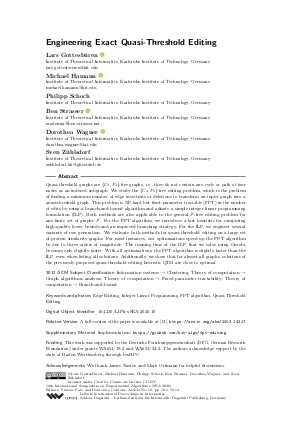@InProceedings{gottesburen_et_al:LIPIcs.SEA.2020.10,
author = {Gottesb\"{u}ren, Lars and Hamann, Michael and Schoch, Philipp and Strasser, Ben and Wagner, Dorothea and Z\"{u}hlsdorf, Sven},
title = {{Engineering Exact Quasi-Threshold Editing}},
booktitle = {18th International Symposium on Experimental Algorithms (SEA 2020)},
pages = {10:1--10:14},
series = {Leibniz International Proceedings in Informatics (LIPIcs)},
ISBN = {978-3-95977-148-1},
ISSN = {1868-8969},
year = {2020},
volume = {160},
editor = {Faro, Simone and Cantone, Domenico},
publisher = {Schloss Dagstuhl -- Leibniz-Zentrum f{\"u}r Informatik},
address = {Dagstuhl, Germany},
URL = {https://drops.dagstuhl.de/entities/document/10.4230/LIPIcs.SEA.2020.10},
URN = {urn:nbn:de:0030-drops-120849},
doi = {10.4230/LIPIcs.SEA.2020.10},
annote = {Keywords: Edge Editing, Integer Linear Programming, FPT algorithm, Quasi-Threshold Editing}
}

 Creative Commons Attribution 3.0 Unported license
Creative Commons Attribution 3.0 Unported license

